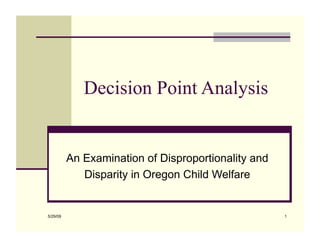
Decision Point Analysis
- 1. Decision Point Analysis An Examination of Disproportionality and Disparity in Oregon Child Welfare 5/29/09 1
- 2. A Study with 3 Components n Conducted by: The Center for Improvement of Child and Family Services within the School of Social Work at Portland State University n Conducted for: The Oregon Department of Human Services and the Oregon Commission on Children and Families and the Governor’s Task Force on Disproportionality in Child Welfare n Sponsored by: Casey Family Programs Center for the Improvement of Child and Family Services 440 University Building 520 SW Harrison, Suite 440 Portland, Oregon 97201 5/29/09 2
- 3. 3 Study Components n Analysis of Administrative Data n Annotated Bibliography n Focus Group Analysis 5/29/09 3
- 4. Areas the Administrative Data Component will address n The existence of disproportionality & disparity n The extent of disproportionality & disparity n The specific groups affected n The specific decision points 5/29/09 4
- 5. Decision Point Analysis Work Group n Group of Oregon DHS child welfare staff: n Met 3 times n Provided: advice & n A process for making decisions n 3 Major Decisions: n What decision points/other areas to include n What time frame for the data n How to define ‘foster care’ 5/29/09 5
- 6. Decision Point Analysis Work Group Members: n Stacey Ayers n Cheryl Baldomarolucas n Anna Cox n Maria Duryea n Beth Englander n Kevin George n Kory Murphy n Catherine Stelzer n Shirley Vollmuller 5/29/09 6
- 7. Disproportionality and Disparity Definitions n Disproportionality: when a group makes up a proportion of those experiencing some event that is higher or lower than that group’s proportion of the population n Disparity: a comparison of one group (e.g, regarding disproportionality in services, outcomes) to another group 5/29/09 7
- 8. Disproportionality: an Example Oregon child protective services 5/29/09 8
- 9. Disproportionality Index: an Example Oregon & Multnomah County foster care n Children in care 2 – 4 years: n White NH 0.791 0.565 n Asian NH 0.227 0.531 n Hispanic 0.355 0.327 n Black NH 2.125 2.436 n Native American NH 10.5 22.75 (in care on 12/31/07) (N=1,451) (N=385) Oregon Mult. Co. 5/29/09 9
- 10. Disproportionality & Disparity Index: an Example: in foster care 2-4 years n Disproportionality Index: n White 58.7% in care / 74.2% in pop. = 0.791 n Black 6.8% in care / 3.2% in pop. = 2.125 n Disparity Index: n 2.125/0.791 = 2.686 5/29/09 10
- 11. Decision Points Selected n Reporting: All Child Protective Services/ Child Abuse & Neglect reports in calendar year 2008 5/29/09 11
- 12. Decision Points Selected (cont.) n Screening: Reports assigned for full field assessment (referrals/‘completed assessments’) and those reports not assigned for full field assessment (‘closed at screening’) 5/29/09 12
- 13. Decision Points Selected (cont.) n Disposition: referrals based on their disposition: n Referrals assessed as ‘founded’ n Referrals assessed as ‘unable to determine’ n Referrals assessed as ‘unable to determine’ with the reason of, ‘unable to locate’* n Referrals assessed as ‘unfounded’ n Referrals assessed as ‘no CPS assessment required’ 5/29/09 13
- 14. Decision Points Selected (cont.) n Removal – non-removal: ‘Founded’ referrals with a ‘removal/hold’ designation and those ‘Founded’ referrals without a ‘removal/ hold’ designation 5/29/09 14
- 15. Decision Points Selected (cont.) n Children in foster care (a 6-month cohort): All children in foster care; by type of care groups; by length of stay in care groups 5/29/09 15
- 16. Decision Points Selected (cont.) n Permanency: Children by type of primary permanency plan and children exiting foster care to permanency by type of exit 5/29/09 16
- 17. Decision Points Selected n Reporting n Screening n Disposition n Removal/Hold n Foster Care n Primary Permanency Plan n Exit from Foster Care
- 18. Thanks! 5/29/09 18